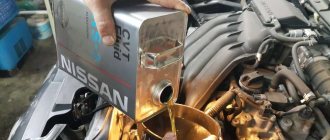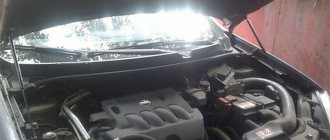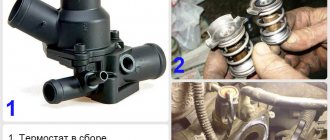When should you change the oil in a Nissan Qashqai CVT?
According to technical recommendations, it is recommended to change the oil in the Nissan Qashqai variator every 50 thousand kilometers, but there are cases when changing the oil in the variator is simply necessary.
To check the condition of the oil in the variator, it is recommended to perform the following steps:
- Pull out the dipstick and place a drop of oil on a clean cloth. Cloudiness will tell you that there are a lot of wear products in the technical fluid. In addition, the presence of a burning smell will tell you about frequent overheating of the working fluid, which happens due to a malfunction of the variator cooling system or a drop in pressure in the lubrication system
- In the operation of the ECU of the Nissan Qashqai, there is a mathematical algorithm for calculating the remaining life of the working fluid. The calculation takes into account the total operating time of the variator, oil temperature and operating loads.
The methods described above are the only ways to check the condition of the oil. But color, smell, consistency, and even more so the aging counter, do not allow you to check the real physical properties of the transmission fluid in the variator. Therefore, we recommend adhering to the following rules:
- change the oil in the variator after purchasing a used car. Repairing CVT transmissions is too expensive to rely on the words of the former owner and even receipts for payment of work orders for replacing the fluid at a service station. There are often cases when craftsmen neglect to remove the pan and replace the filter elements;
- adhere to recommended replacement intervals. It is possible that you will have to go against the car manufacturer. Many operating manuals indicate that the oil in the CVT box is filled for its entire service life and does not require replacement.
How often should the variator be serviced?
Nissan CVT
According to the regulations, the lubricant in the Nissan CVT must be changed after 60 thousand kilometers. So keep an eye on the meter. In addition, the following characteristic signs may indicate the need for replacement:
- Jerking when starting to move due to the accumulation of metal shavings on the pressure reducing valve.
- Jamming causes mismatched operation of cone-shaped pulleys.
- Increasing the operating temperature of the lubricant inside the continuously variable transmission.
- Extraneous noise while driving.
- Old oil and accumulated wear products contribute to bearing noise.
CVT design
The operating conditions of a continuously variable transmission (road surface characteristics, time of year, driving style) determine its service life - up and down.
In practice, it is recommended to change the CVT fluid every 30-40 thousand km.
In parallel with changing the oil, it is necessary to install a new fine filter and clean the pan. During the first maintenance, the coarse filter is simply washed and replaced. On used cars, it becomes necessary to clean the chip-catching magnets.
Consequences and symptoms of untimely replacement
If you do not change the oil on time, then serious problems with the quality operation of the variator cannot be avoided. The purpose of the lubricant is to lubricate the components of the box, and if it is not changed, the parts begin to rub against each other and their wear accelerates.
As a result, the transmission channels become clogged with metal shavings from the parts being ground in. This entails a drop in the pressure level in the variator, which subsequently negatively affects the functioning of the box as a whole.
Symptoms signaling the imminent failure of the variator:
- increasing the time period for warming up the box;
- drop in power plant power indicators;
- jerks and jolts when changing the position of the lever;
- drop in oil level.
This is interesting: Car tuning
Consequences of underfilling
If there is insufficient oil in the box, metal shavings begin to form due to excessive friction of the parts. The oil pump becomes clogged, which easily leads to failure of both the pump itself and the variator. These problems can arise several years later when the warranty expires, but it is not uncommon for the transmission to need to be replaced within a couple of months after purchasing the car.
If, after checking, it is discovered that the oil does not reach the minimum permissible mark, it is necessary to urgently add the required amount, and not put the problem on the back burner. Delaying the time to solve the problem leads to wear of parts and breakdown of the variator, the replacement of which is expensive. However, you need to add it very carefully, since you cannot allow the oil to overflow.
Plug instead of the Nissan variator dipstick
Consequences of overflow
Even exceeding the maximum permissible level by one millimeter can cause many problems. During operation, the transmission fluid foams. This is the reason for the instability of revolutions (drop/increase) in mode D, the car starts moving with strong jerks.
Exceeding the oil level in the variator is not always a consequence of oil overflow. Often it rises due to antifreeze entering from a damaged radiator. This is easy to determine because the liquid changes color.
Foamed oil in the variator
The overflow problem can be solved quickly and easily. To do this, you need to pump out the excess with a syringe connected to a dropper hose, which is inserted into the variator.
What to do if the oil level is higher or lower than required?
If the oil level in the continuously variable transmission is below the permissible level, topping up will be required. In this case, only oil of equivalent characteristics is used. To test the product, you can mix a drop of old and new oils. Precipitation and a change in color indicate that the liquid selected for refilling cannot be used.
Excess oil can be pumped out through the dipstick hole.
Since overfilling is undesirable, it is necessary to check the dipstick when bringing the oil level to normal. If the level is higher than acceptable, pumping will be required. For this, a syringe with a rubber tube is used. The tip must be clean to prevent debris from getting into the box. Pumping is similarly controlled using a probe.
How often should the variator be serviced?
Nissan CVT
According to the regulations, the lubricant in the Nissan CVT must be changed after 60 thousand kilometers. So keep an eye on the meter. In addition, the following characteristic signs may indicate the need for replacement:
- Jerking when starting to move due to the accumulation of metal shavings on the pressure reducing valve.
- Jamming causes mismatched operation of cone-shaped pulleys.
- Increasing the operating temperature of the lubricant inside the continuously variable transmission.
- Extraneous noise while driving.
- Old oil and accumulated wear products contribute to bearing noise.
CVT design
The operating conditions of a continuously variable transmission (road surface characteristics, time of year, driving style) determine its service life - up and down.
In practice, it is recommended to change the CVT fluid every 30-40 thousand km.
In parallel with changing the oil, it is necessary to install a new fine filter and clean the pan. During the first maintenance, the coarse filter is simply washed and replaced. On used cars, it becomes necessary to clean the chip-catching magnets.
Which oil to choose for Nissan cars?
The original oil in the Nissan variator has the following markings: CVT NS-1, CVT NS-2, CVT NS-3. NS-1 is a first generation synthetic designed for Jatco continuously variable transmissions. It is poured into the boxes of Nissan cars produced before 2006 - Primera, Cube, March, etc.
NS-2 was developed for Hyper CVT gearboxes installed on cars after 2006 - Qashqai, X-Trail, Teana, Murano, Note, etc.
NS-3 will be required for 2012-2013 cars. release with continuously variable transmission. Used for the following Nissan models - Pathfinder, Teana, Serena, Altima.
Other manufacturers of CVT oil
Filling a Nissan CVT with non-original fluid is a risky undertaking. Incompatibility with factory lubricant, lack of necessary additives affects the service life of the box, and its repair is an expensive procedure. There are several analog options on sale that have proven themselves among Nissan car owners:
Idemitsu CVTF - designed for Jatco CVTs. In the list of relevant fluids, the manufacturer indicates the entire line of Nissan transmission fluids. Ravenol CVTF NS2/J1 Fluid is an oil of German origin, designed for use in JF010E and JF011E CVTs. A distinctive feature is green color. Nissan models for which the fluid is designed are Qashqai (Dualis), X-Trail, Serena, Lafesta. Febi Bilstein CVT is another German brand that is officially supplied to the Mercedes-Benz auto concern. The manufacturer claims the oil is compatible with original fluids for Nissan CVTs.
CVT Jatco JF15
What CVTs are equipped with the Nissan Qashqai?
Unlike classic automatic transmissions and robotic gearboxes, CVTs are smoother, more efficient and less expensive.
The supplier of CVTs for Renault-Nissan cars is Jatco. The Nissan Qashqai configuration includes three types of CVT gearbox depending on the engine type. The low-power 1.2 DIG-T (115 hp) is equipped with one CVT, the 2-liter naturally aspirated (144 hp) is equipped with another, and the most durable type of CVT is provided for the 1.6-liter turbocharged engine (144 hp). 130 hp). The chain drive mechanism allows the CVT to develop torque up to 380 Nm; the Infiniti QX 60 is equipped with similar transmissions.
The last two types of CVTs for Nissans are officially supplied to the Russian market. They are equipped with the latest generations of cars.
The second generation of CVTs produced by Jatco includes the JF010E and JF011E models, which belong to the so-called tenth family. The later model JF011E is supplemented with naturally aspirated gasoline engines of 2.0 and 2.5 liters, the earlier JF010E is paired with 3.5 liter power units.
We recommend
“Do I need to change the oil in a manual transmission?” More details
CVTs have no design differences. The difference is that a number of elements are made with greater reinforcement to withstand higher torque. The JF011E CVTs were equipped with the penultimate generation Nissan Qashqai and X-Trail, as well as the last two generations of the Mitsubishi Outlander. The JF010E model was equipped, for example, with the Nissan Murano (Z50 and Z51), as well as the Tiana (J31 and J32).
The tenth family of Nissan CVTs has no serious shortcomings; they are designed for a range of 150–200 thousand km. By the end of this period, the wear of the cone and belt, cone bearings, their seating points in the housing, valves in the valve body, and oil pump reaches critical values.
The reliability of CVT continuously variable transmissions has been tested, including on Russian roads and climate. However, among models of certain years of production, widespread malfunctions were noted.
Checking the oil level in a Nissan continuously variable transmission
How to check the lubrication in a Nissan Qashqai variator? An important condition is that the engine must be warmed up (up to 50-80 degrees), since an error in both directions can seriously affect the operation of the car. In the hot season, after a trip, you need to let the engine sit for a while.
This is interesting: How to replace the ignition switch cylinders
If a low oil level is detected, you need to find the reason - probably a leak in the continuously variable transmission. Color and smell are two factors to pay attention to. Dark oil with a burnt smell is a signal for diagnosing and repairing the variator. The presence of chips in the oil indicates the need to replace the radiator and flush its tube.
Stages of checking the oil level in a Nissan variator with a dipstick
- Vehicles are installed on a horizontal surface - tilting is not allowed. The check is performed with the engine idling.
- Alternately, the lever is switched in each position (P, R, N and D) by pressing the brake pedal and held for five to ten seconds. After this, the variator is set to mode P and the brake is released.
Nissan CVT dipstick latch
- You need to open the hood and remove the dipstick from the variator neck, marked “Transmission” or CVT. To release the oil level dipstick, press the locking latch. To avoid getting dirty, it is recommended to arm yourself with special gloves or rags in advance.
- After removing the dipstick, it is necessary to thoroughly wipe it dry with a clean rag that does not leave small particles or threads, since they, as well as moisture, can lead to all sorts of problems if they get inside the variator.
- The cleaned dipstick is lowered into the neck completely without snapping the latch and is held there for five to ten seconds. After removal, a trace of oil remains on it, indicating the real level.
- The dipstick has marks for the highest and lowest permissible levels. Ideally, the oil trace on the surface of the dipstick should be in the HOT range. On different Nissan Qashqai j10, Teana models, the mark may be indicated “add – 1pt” or “don’t – full – max”.
- After determining the existing oil level in the variator, the dipstick is lowered back into the neck and securely fixed with a latch. The check is completed.
The procedure is simple and even Nissan drivers with little experience can easily cope with it. It is important that the engine does not stop idling during the procedure.
Marks on the Nissan variator dipstick
What to do if there is no dipstick?
On models Nissan JUKE, Qashqai j11, X-Trail T32 or other variations, there is a plug instead of a dipstick. In this case, checking the oil level will be more difficult. Most often, for this purpose, they contact an authorized service center, where the procedure is performed by specialized specialists.
Filler/inspection hole for Nissan variator
Those who do not want to, cannot urgently drive to a service station or want to save money, can try to check the amount of oil by draining it. The variator is equipped with a special control hole (filler hole). The box must be heated to forty degrees, and the control must be unscrewed (with the engine running). Oil begins to flow out of the channel in a thin stream. If it does not flow, you need to add until oil appears. Then the plug is screwed in and the procedure can be considered complete.
We make the dipstick ourselves
If the second method seems too complicated and time-consuming, then you can make the probe yourself. First you need to remove the plug in the place where the dipstick should be located. Next, you need to measure the depth from the edge of the box to the pallet. You can do this using a metal cable and try to find a compatible probe of the right size. An oil meter can be purchased from another Nissan model.
Sometimes they encounter a difference in length, but the dipstick can be shortened and glued into the car plug. This way, measuring the oil level in the variator will no longer be a problem.
Nissan variator dipstick
Checking the oil level
Not only will the CVT deteriorate, but checking the level may also indicate that the lubricant needs to be replaced. Therefore, you need to do this periodically. The check is not difficult because Qashqai cars have a dipstick.
Here's how to check the oil in the variator:
- Warm up the car to operating temperature (50-80 degrees Celsius). If the engine is overheated, then vice versa - let it cool a little.
- Place the car in a level horizontal position. Do not turn off the engine.
- Press the brake pedal. Consistently switch the selector through all positions at intervals of 5-10 seconds.
- Move the lever to position P. Release the brake pedal.
- Find the filler neck of the retainer. She is o or "CVT".
- Unclip the dipstick lock and remove the dipstick from the filler neck.
- Wipe the dipstick with a dry, clean, lint-free cloth and put it back in place. Do not snap the latch.
- Remove the dipstick again and check the oil level. It should be on o (or full, max, etc.).
- Insert the dipstick into place and secure it with the latch.
If the oil itself is not yet old, but the level is below normal, then you need to try to find the reason. Most likely, this indicates a leak somewhere in the system. If the oil has darkened and there is a burning smell, it needs to be changed. If very little time has passed since the previous replacement, it is worthwhile to diagnose the variator for breakdowns. If there is an admixture of metal shavings in the oil, then the problem is in the radiator.
The process of changing the oil in Qashqai with a CVT
You can change the oil in a Qashqai with a CVT yourself. To do this, you need to go into the garage and turn off the engine. The driver has 15-20 minutes for all actions while the gearbox and engine are hot. To change the oil, you need to acquire the following tools:
- two 4-liter cans of oil;
- “flat” screwdriver;
- container into which the waste will be drained (volume no less than 3 liters);
- set of wrenches - wrenches and open-end wrenches;
- watering can;
- two or three clean rags or rags;
- rubber seal for the pallet;
- cleaning agent for the pan and filter (ordinary diesel fuel will do);
- coarse filter (if it is impossible to wash an already installed mesh).
This is interesting: How to choose the right Renault Megane spare parts: advice for an inexperienced driver
Before starting this process, you must be very careful and strictly follow the following steps:
1. Install the SUV on the pit.
2. Remove the power plant protection.
3. Find the plug and place a waste container under it.
4. Unscrew the plug - a wrench will help.
5. Unscrew the screws that secure the pan and carefully remove it (waste oil may remain in it).
6. Inspect the magnets located inside the tray. If necessary, clean the products.
7. Remove and clean the filter mesh. If unsuccessful, replace with a new one.
8. Return the filter and magnets to their place. Replace the worn rubber pan seal using sealant.
9. Install the pallet and check that the bolts are securely fastened.
10. Pour oil into the variator using a watering can.
11. Drive a few meters (up to approximately 1 kilometer).
12. Measure the oil level and, if necessary, add to the mark.
Necessary tools and spare parts, consumables
To replace it yourself, you will need the following tools:
- pliers;
- flat screwdriver;
- socket wrench or socket for 10 and 19;
- open-end wrench 10;
- funnel.
And the following consumables (original numbers are indicated in brackets):
- original NISSAN CVT Fluid NS-2, ~8 l (KLE52-00004);
- seal for variator pan NISSAN GASKET OIL-PAN (31397-1XF0C / MITSUBISHI 2705A015);
- variator heat exchanger filter (MITSUBISHI 2824A006 / NISSAN 317261XF00);
- variator heat exchanger housing gasket (MITUBISHI 2920A096);
- Qashqai coarse variator filter (NISSAN 317281XZ0D / MITSUBISHI 2824A007);
- gasket for drain plug (NISSAN 11026-01M02);
- drain plug - just in case the thread on the old one breaks (NISSAN 3137731X06).
In addition, you will need empty containers of sufficient volume to drain the waste, clean rags, and a cleaner.
How to change oil on Nissan Qashqai: CVT in the hands of professionals
The cost of a variator is several times higher than the price of replacement work at a car service center, so it’s not worth the risk. There are two ways to change the oil:
- Partial fluid replacement without changing the coarse filter;
- Complete replacement. In this case, the pan is dismantled and the filter and magnetic traps are cleaned.
Car service specialists recommend performing a complete fluid change. For this purpose, preparatory work is carried out. Raise the car on a lift. Remove the engine protection and the front left wheel. Remove protection. After this, the replacement proceeds according to the following algorithm:
- Drain the waste into a container by unscrewing the drain plug;
After the liquid has drained, unscrew the pan. A little waste remains in the pan, so care should be taken when dismantling it;- Remove the coarse filter and wash it. If the deposits are not washed off, the filter mesh is changed;
- The tray is cleaned of deposits, and metal shavings are removed from the magnets;
- The pan is washed in an ultrasonic bath;
- The filter is installed in place. Before installing the pan, it is necessary to change the gasket. Be careful when tightening the pan bolts. Do not apply too much force when twisting;
- Be sure to change the copper gasket of the plug;
- Drain the fluid from the CVT radiator. To access it, remove the air filter, battery and platform under it. The wheel is dismantled during the preparation process;
- Remove the clamps and use a compressor to remove liquid from the radiator;
- Unscrew the cooler and change the fine filter in it;
- The cooler is washed in a bath using ultrasound;
- Reassemble the device in reverse order;
- After the variator is assembled, oil is poured into the device through the fluid control hole;
- Check the oil level. In a cold variator it should be between the marks. Please note that when checking the oil level, wipe the dipstick only with a lint-free cloth.
After changing the oil, it is necessary to reset the oil aging sensor. If it is not reset, the oil pump will produce increased pressure, which will not prolong the operation of the variator.
How to extend the life of a variator?
The resource of Nissan CVTs is very limited, so the question of extending it is quite appropriate. The following recommendations can be given:
- In winter, the car must warm up; you should not move away without warming up.
- The sensors need to be checked periodically and cleaned if necessary; errors generated by the on-board computer should not be ignored.
- When servicing the variator, it is necessary to clean the radiator.
- It is advisable to completely replace the lubricant in the CVT; add it only when a low level is detected.
- The driving style should be calm - sharp accelerations and prolonged driving at high speed shorten the service life of the variator.
- You should not use a car with a CVT to tow other vehicles.
Fine filters for Nissan variator
Storage conditions for transmission fluid must be strictly observed. It is better to carry out lubricant replacement work indoors to prevent debris from entering.
Filters must be changed after 60,000 km.
What to do if the oil level is higher or lower than required?
If the oil level in the continuously variable transmission is below the permissible level, topping up will be required. In this case, only oil of equivalent characteristics is used. To test the product, you can mix a drop of old and new oils. Precipitation and a change in color indicate that the liquid selected for refilling cannot be used.
Excess oil can be pumped out through the dipstick hole.
Since overfilling is undesirable, it is necessary to check the dipstick when bringing the oil level to normal. If the level is higher than acceptable, pumping will be required. For this, a syringe with a rubber tube is used. The tip must be clean to prevent debris from getting into the box. Pumping is similarly controlled using a probe.
What do car forum participants think about replacing the CVT in the Nissan Qashqai?
1. Is it possible to replace the CVT with a manual transmission in the Nissan Qashqai?
Is it possible to replace the CVT with a manual instead? I used to drive a Peugeot 406 coupe; it was a fairly common practice in the club. I didn’t change it specifically, but I personally know those who did. They changed the transmission, wiring, flywheel and lining (I don’t remember, maybe something else).
Answer. Such a replacement is possible on almost any car; it is only necessary that the engine be suitable for both automatic transmission and manual transmission. All you need is money and desire, I helped replace a friend’s Opel. You can’t do without a transmission, clutch kit, flywheel, brake master cylinder, pedal with filling, gear lever, wiring to the box.
2. I wanted to replace the bearings, but I replaced almost the entire variator
“I contacted the service center to replace the bearings. The cost was announced - 20 thousand rubles, it included work and an oil change. We agreed that the specialists would report by sending photos to the messenger (there was a lot of work, it had to be done during the week in order to pick up the car on the weekend).
They disassembled the variator and said that the cone, belt, oil pump, etc. needed to be replaced. And the time to make a decision was almost half a day. Since there was no time to think at that moment, I agreed to their proposal. The cost of new spare parts was announced lower than in Exist/Autodoc, and, in general, driving around Moscow without a car to buy spare parts is a dubious pleasure. Maybe it was possible to look for something cheaper, but, unfortunately, there was no time.”
What oil is required and in what quantity
The quality of operation of your Nissan Qashqai automatic transmission depends on the correctly selected transmission fluid. And the correct amount of liquid poured in indicates further consequences. Therefore, it is recommended to fill the variator with NISSAN CVT Fluid NS-2 oil (it has the original code KLE52-00004). You will need 2 canisters (each with a capacity of 4 liters). Remember that before starting the procedure and after finishing it, you need to check the level in the gearbox. The transmission fluid should be no less than o and no more than o.
NISSAN CVT Fluid NS-2 oil
This is interesting: How many liters of antifreeze in a VAZ 2107
Oil change intervals and necessary spare parts
According to the service book regulations, the oil in the variator should be changed every 60 thousand km. But given the poor condition of domestic roads, it would be much better to replace them after 30-40 thousand km. The choice of spare parts should be approached responsibly, but it is still better to focus on original parts. It is also worth noting that regular ATF is not suitable for a variator like it is for an automatic transmission. It is necessary to fill it with special NISSAN CVT Fluids NS-2. The required oil volume for a complete change is 8 liters (2 canisters of 4 liters each), original number KLE5200004.
In addition to the liquid, you also need to purchase the following consumables:
- transmission pan gasket with original number 31397-1XF0C;
- pan drain plug gasket, original number 11026-01M02;
- oil cooler housing O-ring, original number 2920A096;
- gearbox oil cooler oil filter, number 317261XF00;
- variator coarse filter, with original number 317281XZ0D (replaced if necessary and when it is very clogged).
For the original numbers presented, there are similar replacements from various manufacturers, but it is still better to give preference to original parts and fluids; the CVT is no joke.
The differential is an integral part of your car. Without this element it would be difficult to turn in your car. A differential allows the wheels on your car or truck to spin at different speeds. Because the inside wheel moves a short distance when the car turns, it needs a differential.
All vehicles have differentials of some kind. In front-wheel drive cars, the differential is located at the front and is called the gearbox. In rear-wheel drive vehicles, the differential is located at the rear. All-wheel drive vehicles have differentials at both the front and rear.
The differential contains fluid that lubricates and cools the gears. Like any other lubricant, differential fluid breaks down over time. Together with the engine, the differential is very demanding on oil and condition.
You should consider checking your front or rear differential fluid more frequently if:
- Maintenance is limited to oil changes at recommended intervals.
- The harder you drive, the faster your differential fluid breaks down.
- You should consider checking your front or rear differential fluid more frequently if:
- You often tow a boat, caravan or trailer. The rear axle of your vehicle is partially submerged when you launch your boat off the ramp.
- You are driving in difficult conditions, for example, the road is covered with snow. You are an off-road enthusiast and cover rough or wet terrain.
We recommend warming up the variator. How to do this correctly?
So, operating a cold variator, especially at very low temperatures, is harmful. It is advisable to warm it up. But among owners of cars with a CVT, there is no consensus on how to properly warm up a car with such a gearbox. On specialized forums there are constantly debates about methods of warming up. At the same time, many car owners try to apply the rules for warming up a classic automatic transmission to CVTs, and this is fundamentally wrong.
Warming up while moving
One of the options for warming up is warming up while driving. The point is that you immediately start driving without warming up, but do not “rape” the car for a certain time. That is, you move carefully, without sudden acceleration or braking, you press the gas pedal smoothly, you don’t accelerate the engine to high speeds, and you don’t move at high speed. Some people always drive like this.
In this case, both the engine and the variator warm up gradually as you drive, and the gentle “cold” mode does not allow the mechanisms to wear out too much.
Warming up in the parking lot
This method requires you to spend an additional 5-20 minutes before departure. We leave early, start the car and sit and wait until everything warms up.
Classic warm-up and start driving only after the car engine has warmed up. And along with the engine, the variator also heats up, since they are assembled together.
This method is actually used by everyone who has an automatic engine start from the alarm remote control installed. True, the variator warms up worse, because it only receives heat from the engine. The variator itself does not generate heat when there is no movement. In fact, the variator will warm up completely only after you start driving.
Incorrect warm-up similar to an automatic transmission
Many people are accustomed to warming up the automatic transmission while parked by switching it to the “Drive” mode, or alternately switching the “PRND” modes and back. And by analogy, and sometimes on someone’s advice, they also begin to warm up the variator. Yes, for a classic automatic transmission this is the correct method, since it allows you to “disperse” the oil through all channels of the “automatic” when switching modes. But the design of the variator is fundamentally different from the classic automatic, so switching modes practically does not change anything and does not improve warming. Perhaps, before starting to drive in cold weather, you can switch the “N” (neutral) mode for a few seconds to slightly stir up the starting fluid coupling (variator clutch). Thus, there is no point in twitching the gearbox modes back and forth; it’s better to just wait for it to warm up.
Optimal warm-up of the variator (recommended)
Authoritative experts admit that the variator requires warming up, but the method depends on the ambient temperature.
Proper warming up is a comprehensive warming up while parked and then while driving.
Such warming up during the cold period will be the key to the long and reliable service of your variator.
The warm-up time should depend on the outside temperature. Here is a summary table of the correct warm-up of the CVT gearbox:
| Air temperature | Pre-warming while parked | Warming up while moving |
| Above 0 degrees | Not required | Not required |
| From 0 to -5 degrees | Not required | 3-4 minutes |
| -5 to -10 degrees | 3-5 minutes | 5-7 minutes |
| -10 to -15 degrees | 5-10 minutes | 10-15 minutes |
| -15 to -23 degrees | 10-15 minutes | 15-20 minutes |
| From -23 to -30 degrees | 15-20 minutes | 20-30 minutes |
| -30 to -35 degrees | 20-30 minutes. Use only when necessary. | 30-40 minutes. It is advisable to use it in a gentle mode all the way. |
| Below -35 degrees | Operate the variator at your own risk. We recommend that only vehicles with a warmer temperature, or vehicles with a pre-heater, leave the garage. |
The table shows approximate times, since the duration of warm-up depends very much on the power and design of the engine. But based on these numbers, you can create your own warm-up plan, guided by the current temperature of your car’s engine and your feelings.
Then your variator will only delight you with its advantages.
Write about your experience of operating a variator in cold weather.
Instructions
Changing the oil in the Nissan Qashqai J11 and J10 variator is carried out in a similar way, because the design of the transmission itself is similar. Sequence of actions at home:
- Warm up the car to normal operating temperature. To do this, just drive a little along the street as usual, 10-15 km is enough.
- Drive the car into the garage, place it on a viewing hole or a lift. Turn off the engine.
- Remove the engine protection.
- Start the engine again. Alternately switch the variator lever in all positions with a delay of 5-10 seconds. Then leave the selector in the parking position (P).
- Without turning off the engine, assess the oil level in the variator (read how to do this above).
- Turn off the engine and put the dipstick in place, but do not snap it into place. This is necessary so that the system is not airtight. When communicating with air, the liquid will merge faster and more efficiently.
- Unscrew the drain plug, not forgetting to place a large container under it. The waste will be about 6-7 liters, you need to take this into account when choosing an empty container. It is convenient if the volume of oil drained from the box can be measured. Then it will be clear how much fresh liquid to fill.
- Wait until the oil drains. This usually takes no more than 20 minutes.
- At this time, you can start replacing the heat exchanger (oil cooler) filter of the variator. Remove it, and also, if possible, remove and wash or replace the variator cooling radiator.
- When all the used oil has poured out, tighten the drain plug.
- Remove the transmission pan. It is important to note that it contains a small amount of oil - about 400 ml. Therefore, it should be removed extremely carefully. Otherwise, all the oil will spill and may get on your hands and clothes.
- The pan should be thoroughly cleaned of thickened residues of old oil. Any cleaning liquid or solvent will be useful here. You also need to clean the gaskets and remove metal shavings from the two magnets. A variator, like no other type of gearbox, is especially susceptible to metal shavings. Therefore, this replacement step should not be neglected.
- Change the coarse filter. Replace the pan seal. Dry the tray itself and put it in place. It is secured with bolts. It is important to take into account that the threads on them easily break off, and the lid itself, if it is tightened too much, becomes deformed. Therefore, tighten the pallet bolts without applying excessive force.
- Change the copper washer on the drain plug. Replace the plug and tighten it.
- Using a funnel, pour fresh oil into the variator through the oil dipstick hole. Its volume should be equal to the volume of the drained one.
- After changing the oil, you should evaluate the level using the dipstick as described above. If it turns out to be less than needed, then add more. Overfilling is also undesirable, so if the level is exceeded, the excess should be pumped out with a syringe with a rubber tube.
The described method allows you to partially change the oil in the variator. A complete replacement is carried out using the replacement method - when the old oil is replaced by a new one. To do this, you can fork out for an additional amount of oil and repeat the procedure. It is better to do this in 2-3 days, driving the car as usual. However, the regulations state that a partial replacement, in which 60-70% of the fluid is changed, is sufficient for the normal functioning of the variator. It is important to change all the specified filters, clean the pan and magnets. If this is not done, the effectiveness of fresh oil and the replacement procedure in general will decrease.











